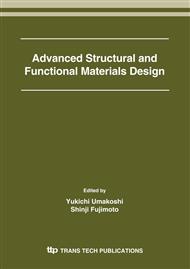p.137
p.145
p.153
p.159
p.165
p.171
p.177
p.183
p.189
Magnetism of Ultrathin Fe Films in the Vicinity of Transition from Ferromagnetism to Superparamagnetism
Abstract:
We have investigated the magnetism of ultrathin Fe films grown on the inclined Al2O3(0001), especially, in the vicinity of ferromagnetic-superparamagnetic transition. In the transition region, the magnetic state of Fe films is the coexistence of ferromagnetism and superparamagnetism. The ratio of the components in ferromagnetic and superparamagnetic state is dependent on the growth temperature. For Fe grown on the flat substrate without the inclination, as the growth temperature increases, the ratio of the component in ferromagnetic state increases, reaches to the maximum and decreases again. On the presence of substrate inclination, the ratio of the component in ferromagnetic state increases, reaches to the maximum and decreases again. decreases monotonically with increasing growth temperature. We investigated the dominant factor of the complex magnetic state, and clarified that the complex magnetic state is dominated by the change of the film structure and the effective magnetic anisotropy energy.
Info:
Periodical:
Pages:
165-170
Citation:
Online since:
April 2006
Authors:
Keywords:
Price:
Сopyright:
© 2006 Trans Tech Publications Ltd. All Rights Reserved
Share:
Citation:


